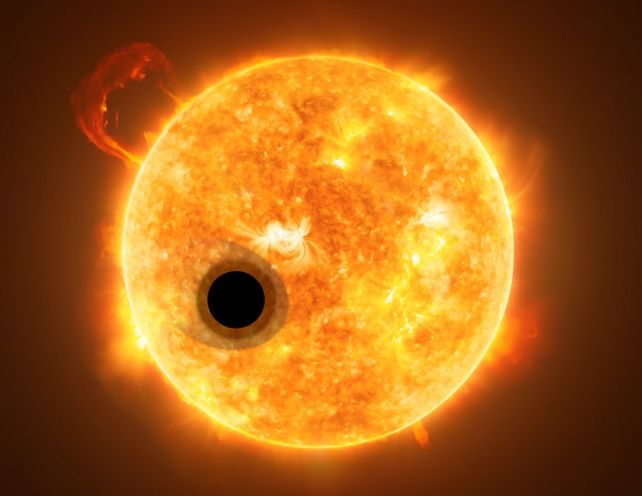Drifting across Earth's line of sight from its parent star, the planet WASP-107b once again reveals something that has scientists baffled.
Located 200 light-years from Earth, the planet WASP-107b has long been famous for its "cotton candy" state, meaning it has a puffy atmosphere due to being too close to its parent star, resulting in a mass that is too low compared to its size.
Now, a new analysis further reveals what makes the planet unique: It has an asymmetrical atmosphere.
In the graphic image provided by scientists - which would be a real image if we could zoom in on what we see many times - WASP-107b looks like a century egg drifting across its parent star, with a dense core and asymmetrically surrounding translucent layers.

Planet WASP-107b resembles a century egg drifting across its parent star as seen from Earth - Graphic: NASA/ESA/M. Kornmesser
"This is the first time the East-West asymmetry of an exoplanet has been observed as it transits its parent star, from space," said astronomer Matthew Murphy from the University of Arizona (USA).
We already know a little about what's in the atmosphere of this strange exoplanet.
Previous analyses based on data from the James Webb Space Telescope showed it possessed a sky filled with sulfur dioxide, water vapor, carbon dioxide, carbon monoxide and sand clouds.
Dr Murphy and colleagues wanted to go further. Using new analytical techniques, they found that there must be differences in atmospheric composition between the planet's eastern and western hemispheres, according to a paper published in the scientific journal Nature Astronomy.
Scientists have detected asymmetries in the atmospheres of exoplanets before, though never through direct observation.
On extremely hot exoplanets, it is thought that the cause is the atmosphere surrounding the planet.
As it reaches the dawn boundary, it heats up; as it reaches the dusk boundary, it cools, condenses, and may even rain.
But WASP-107b has broken new ground.
Not only is there a difference in temperature on either side of the exoplanet, with mornings cooler than evenings, but there is also a slight difference in cloudiness.
This is intriguing, as models suggest that WASP-107b should not have such asymmetry.
Although differences in chemical composition are the most plausible hypothesis, scientists have not yet been able to specifically indicate whether the atmosphere in the eastern half contains compounds that the western half does not, or vice versa.
They hope to answer that question with many more hours of observation.
WASP-107b belongs to the group of gas giant planets, nearly the same size as Jupiter in the Solar System, but its mass is only about 10% of Jupiter, or 31.8 times heavier than Earth.
It is orbiting the orange dwarf star WASP-107 with an orbital period of just 5.7 days.
Source: https://giadinh.suckhoedoisong.vn/ky-la-hanh-tinh-giong-qua-trung-bac-thao-troi-giua-troi-172241011063106053.htm


![[Photo] Anh Hoang - Dinh Duc successfully defended the men's doubles championship of the National Table Tennis Championship of Nhan Dan Newspaper](https://vphoto.vietnam.vn/thumb/1200x675/vietnam/resource/IMAGE/2025/5/23/d6ab3bcac02c49928b38c729d795cac6)
























![[Photo] Top players gather at the 2025 Nhan Dan Newspaper National Table Tennis Championship](https://vphoto.vietnam.vn/thumb/1200x675/vietnam/resource/IMAGE/2025/5/23/9ad5f6f4faf146b08335e5c446edb107)






























![[Photo] The Central Party Executive Committee delegation visits former President Tran Duc Luong](https://vphoto.vietnam.vn/thumb/402x226/vietnam/resource/IMAGE/2025/5/24/32f67673454445aab0f1f2af331cb170)





































Comment (0)